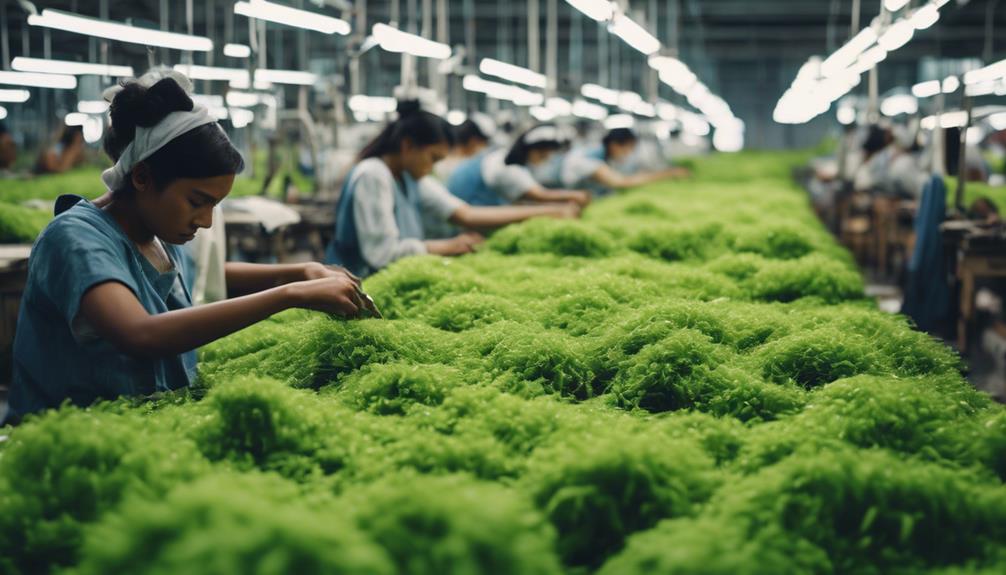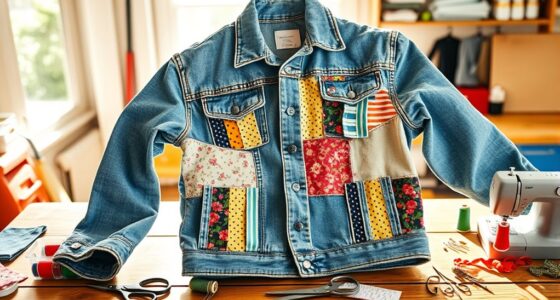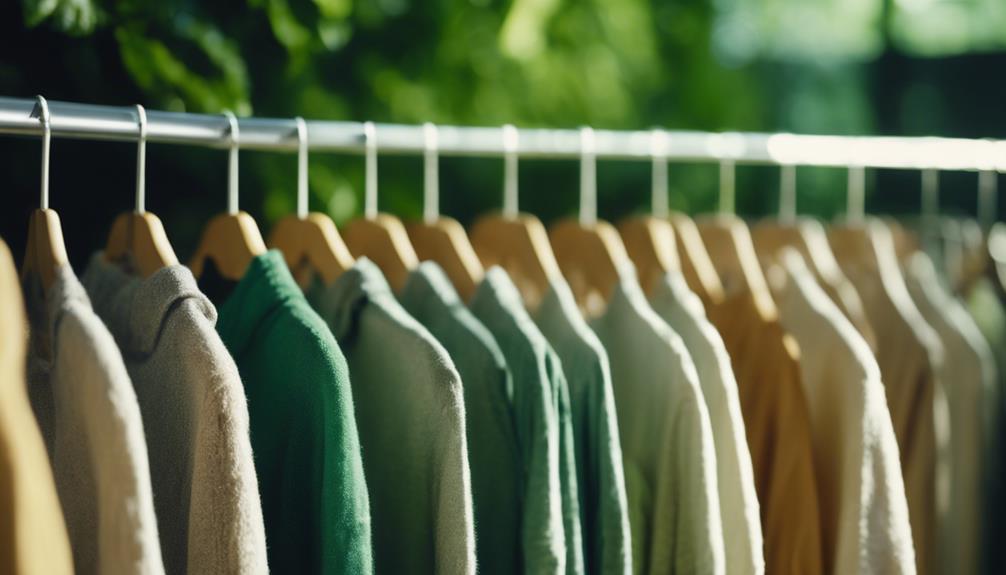You can promote the sustainable use of natural resources in fashion by selecting environmentally friendly materials such as organic cotton and natural fibers. By giving priority to recycling and upcycling, you can help in reducing waste, considering only 1% of clothing is currently recycled. Show support for brands that follow ethical practices and focus on local production to decrease transportation emissions. By choosing quality over quantity, you can lower your environmental footprint. Engaging in secondhand shopping promotes a circular economy and diminishes landfill waste. If you’re looking for more ways to make a significant impact, you’re headed in the right direction for sustainable fashion practices.
Key Takeaways
- Utilize organic cotton and natural fibers to minimize environmental impact and support sustainable agriculture practices.
- Incorporate recycled materials, like polyester, to reduce waste and lower reliance on virgin resources.
- Prioritize local production to decrease transportation emissions and foster community support.
- Design garments for durability and longevity, reducing the frequency of replacements and waste generation.
Understanding Sustainable Fashion
Sustainable fashion focuses on using eco-friendly materials and responsible practices to create clothing that benefits both people and the planet. By prioritizing natural resources, it promotes the use of materials like organic cotton, which grows without harmful pesticides, thereby supporting environmental health and biodiversity. This approach stands in stark contrast to the traditional fashion industry, which produces around 100 billion garments annually and greatly impacts our planet.
You'll find that sustainable fashion emphasizes recycling and upcycling to extend the lifecycle of garments, as currently, only 1% of discarded clothing is recycled. This highlights the need for responsible sourcing and innovative practices that minimize waste. Furthermore, sustainable fashion aims to tackle water pollution, which accounts for about 20% of global pollution, by advocating for methods that reduce water usage during production.
Ethical practices, such as fair labor standards, are also vital. They guarantee that the natural resources used in clothing production are sourced responsibly while supporting communities. By embracing these principles, you can make choices that not only reduce your environmental impact but also contribute positively to the lives of others.
The Impact of Fast Fashion

Fast fashion has created a culture of overconsumption, leading to staggering waste and environmental degradation that starkly contrasts with the principles of sustainable fashion. You're likely aware that the fast fashion industry produces around 100 billion garments annually, with a jaw-dropping 87% ending up in landfills. This rampant waste not only contributes to pollution and waste but also highlights the need for better consumption patterns.
The environmental impact of fast fashion is profound. The apparel industry is responsible for about 4% of global carbon emissions, and this figure could rise to 26% by 2050 if current practices persist. With clothing production doubling since 2000, the pressure on natural resources intensifies, particularly as synthetic fibers dominate, making up 69% of clothing. These materials not only contribute to microplastic pollution but also hinder effective textile recycling.
To combat these issues, adopting sustainable practices in your fashion choices is essential. By prioritizing sustainable materials and supporting brands that minimize their environmental impact, you can help mitigate the waste and pollution generated by the fast fashion industry. Your choices matter; they shape the future of fashion and our planet.
Strategies for Sustainable Materials

Choosing eco-friendly materials can greatly reduce your fashion footprint and promote a healthier planet. By opting for sustainable materials like organic cotton and natural fibers, you support farming practices that prioritize biodiversity and avoid harmful pesticides. These materials not only enhance soil health but also offer biodegradable alternatives to synthetic textiles, minimizing long-term environmental impact.
Incorporating recycled polyester into your wardrobe is another effective strategy. This material is made from post-consumer plastic, which diverts waste from landfills and reduces pollution. By choosing recycled options, you contribute to a circular economy, where resources are reused rather than discarded.
Responsible sourcing is essential. Confirm that your materials meet stringent environmental and social standards, such as those certified by GOTS for organic textiles. This practice guarantees that the entire lifecycle of your clothing aligns with sustainability goals.
Additionally, emphasize local production to cut down on transportation emissions. Supporting local economies not only reduces carbon footprints but also strengthens community ties. By making these conscious choices, you can notably lower your fashion-related environmental impact and foster a more sustainable future.
Consumer Choices Matter

Your everyday fashion choices can considerably shape the industry's direction toward sustainability. When you prioritize quality over quantity, you not only enhance your wardrobe but also reduce the environmental impact of your clothing. Opting for sustainable materials like organic cotton or hemp helps minimize resource depletion and chemical use.
By engaging in secondhand shopping, you contribute to a circular economy, drastically decreasing the demand for new garments. Remember, 87% of clothing produced ends up in landfills, so every purchase counts. Supporting brands committed to ethical fashion practices, such as fair trade and GOTS certification, encourages the use of eco-friendly materials and responsible manufacturing processes.
Educating yourself about the hidden costs of fast fashion empowers you to make informed choices that promote sustainable fashion. The apparel industry accounts for 4% of global greenhouse gas emissions, and your choices can drive change. By consciously selecting sustainable options, you help shift the fashion landscape toward a more sustainable future, proving that consumer choices matter.
Embrace the power of your purchasing decisions, and together, we can create a positive impact on both the environment and the industry.
Innovative Business Models

Innovative business models are reshaping the sustainable fashion landscape by promoting practices like rental and resale, which extend the lifecycle of garments and aim to reduce waste. These approaches align with the principles of sustainability and the circular economy, encouraging a shift in how we consume fashion.
Here are three key strategies making waves:
- Rental Platforms: Renting clothing allows you to enjoy a variety of styles without the need to purchase new items, effectively lowering resource consumption.
- Upcycling Initiatives: Brands are turning discarded textiles into new fashion items, showcasing creativity and addressing textile waste, with pioneers like Reformation leading the way.
- Collaborative Efforts: Partnerships between brands and sustainability-focused organizations foster shared knowledge and resources, enhancing the overall environmental impact of the industry.
Regulatory Measures for Accountability

To guarantee accountability in the fashion industry, you need to understand the role of government frameworks and compliance standards.
Regulations must be enforced to hold brands responsible for their environmental practices.
Government Accountability Frameworks
Government accountability frameworks play an essential role in enforcing transparency and sustainability within the fashion industry. By implementing regulatory measures, governments can hold brands accountable for their environmental impact.
Here are three key elements of effective frameworks:
- Mandatory Disclosures: Companies must reveal their sustainable practices and environmental impacts, promoting transparency in their operations.
- Cost Accountability: Legislation can require fashion brands to bear the costs of their negative environmental impacts, incentivizing them to adopt sustainable practices.
- Compliance Standards: Regulations can mandate specific sustainability benchmarks, such as using biodegradable materials or recycled content in products.
These frameworks create a structured approach that encourages responsible corporate practices and sustainable manufacturing processes.
When brands know they'll face penalties for non-compliance, they're more likely to prioritize environmentally friendly practices. By establishing clear accountability, governments can drive meaningful change, aligning the fashion industry with global sustainability goals.
As consumers, you can support brands that adhere to these frameworks, helping to foster a market that values sustainability and transparency. In doing so, you contribute to a healthier planet and a more responsible fashion industry.
Industry Compliance Standards
Building on the need for accountability in the fashion industry, industry compliance standards are becoming a key regulatory measure that assures brands take responsibility for their environmental and social impacts. These standards compel fashion brands to adopt sustainable practices, guaranteeing they use sustainable materials throughout their supply chain.
Legislation like the EU's Circular Economy Action Plan directly influences brand operations, pushing them to minimize waste and promote eco-friendly alternatives. Compliance standards from organizations like the Global Organic Textile Standard (GOTS) offer criteria that assure transparency and ethical practices in sourcing.
Moreover, the Fashion Sustainability and Social Accountability Act mandates that brands disclose their supply chain practices, including labor conditions and their overall environmental impact. These regulatory measures are essential for fostering genuine sustainability in the fashion industry. By adhering to these standards, brands not only demonstrate their commitment to ethical practices but also help create a more transparent and responsible industry.
As a consumer, you can support these efforts by choosing brands that comply with these standards, encouraging them to prioritize sustainability and accountability in their operations.
Enforcement of Regulations
Enforcing regulations is essential for holding fashion companies accountable for their environmental impact and guaranteeing they adopt sustainable practices. Without strict measures, many brands might prioritize profit over sustainability, leading to further damage to our planet.
Here are three key regulatory measures that can drive change:
- Mandatory Disclosure: Companies should be required to disclose the environmental costs of their production processes, enhancing transparency in the supply chain.
- Use of Eco-Friendly Materials: Regulations can enforce the use of sustainable materials, pushing brands towards greener alternatives and reducing their overall carbon footprint.
- Extended Producer Responsibility (EPR): EPR laws can guarantee that fashion brands manage the lifecycle of their products, promoting proper recycling and disposal practices.
Through the enforcement of regulations, governments can incentivize sustainable practices by offering tax breaks or subsidies for companies committed to eco-friendly production methods.
Such measures not only hold companies accountable but also foster a culture of sustainability within the industry. By demanding accountability, you contribute to a future where fashion respects both people and the planet.
Educating for Change

You can't underestimate the importance of education in transforming the fashion industry.
By understanding sustainable resource management and engaging in consumer awareness campaigns, you can make informed choices that benefit both the planet and your wardrobe.
Let's explore how knowledge can drive meaningful change in your shopping habits and support a more sustainable future.
Importance of Education
Education plays an essential role in transforming consumer habits, empowering individuals to make conscious choices that promote sustainability in fashion. By understanding the full spectrum of the fashion industry, you can be a part of the sustainable fashion movement.
Here are three key areas where education can make a difference:
- Awareness of Sustainable Materials: Learning about eco-friendly options like organic cotton and recycled polyester helps you choose products that minimize environmental impact.
- Understanding Fast Fashion's Consequences: Recognizing that fast fashion contributes to around 4% of global greenhouse gas emissions can shift your consumer choices towards brands that prioritize ethical labor practices and sustainability.
- Embracing Circular Fashion: Education on circular fashion encourages participation in clothing swaps and secondhand markets, reducing landfill waste and promoting a culture of reuse.
Through education on sustainable practices, you can become an informed consumer, advocating for brands that value both the planet and people.
Sustainable Resource Management
Sustainable resource management in fashion requires a commitment to using natural materials that not only reduce environmental harm but also support biodiversity. By choosing sustainable materials like organic cotton, you can help combat the environmental damage caused by synthetic fibers. In doing so, you also address the alarming fact that about 20% of global water pollution stems from the fashion industry. By focusing on efficient water usage in production processes, we can minimize waste and protect our precious resources.
It's essential to adopt strategies that prioritize quality and longevity in clothing. The average garment is worn only around 10 times before being tossed aside, highlighting the need for resource management that encourages durable designs.
Additionally, embracing recycling and upcycling initiatives can drastically reduce waste, as currently, a mere 1% of discarded clothing gets recycled.
Consumer Awareness Campaigns
Consumer awareness campaigns play an essential role in shaping choices that support eco-friendly practices in fashion. By educating you about the environmental impact of your clothing decisions, these campaigns encourage responsible consumption and promote sustainable fashion.
Here are three key benefits of consumer awareness campaigns:
- Informed Choices: With 66% of consumers willing to pay more for sustainable brands, education empowers you to select ethically produced apparel that supports fair wages for garment workers.
- Waste Reduction: Highlighting the staggering fact that 87% of garments end up in landfills inspires you to embrace recycling and secondhand shopping, which are vital for a circular economy.
- Transparency and Trust: Campaigns that share stories about supply chains foster trust, making you more likely to support brands committed to ethical practices.
The Future of Fashion

The future of fashion hinges on embracing innovative practices that prioritize natural materials and resource efficiency. As sustainable fashion grows, you'll see a shift towards using natural biodegradable materials instead of petroleum-based synthetic fibers, which dominate the market. This change not only reduces the environmental footprint but also helps combat the fashion industry's contribution to global greenhouse gas emissions, projected to rise considerably by 2050.
By implementing circular economy principles, you can play a role in decreasing the staggering 87% of garments that currently end up in landfills. Innovative resource management techniques, such as recycling and upcycling, can breathe new life into fast fashion items, transforming waste into valuable resources.
Education on sustainable fabrics is crucial. With only 1% of discarded clothing recycled, there's immense potential for improving resource efficiency. As you make informed choices, you contribute to a more sustainable future in fashion.
Each decision you make can support a system that values longevity and environmental care, paving the way for a thriving industry that prioritizes our planet over profit. Embrace this shift, and you'll be part of a positive change in the world of fashion.
Frequently Asked Questions
How Can We Use Our Natural Resources in a Sustainable Fashion?
You can use natural resources sustainably by choosing eco-friendly materials, reducing waste through recycling, and supporting brands that prioritize responsible production. Educating yourself on sustainable practices also helps in making informed, environmentally-conscious choices.
How Can We Use Our Natural Resources in a Sustainable Way?
You can use natural resources sustainably by adopting efficient practices, like rainwater harvesting and organic farming. Choosing biodegradable materials and supporting responsible forestry will help reduce pollution and preserve ecosystems for future generations.
What Natural Resources Does Fast Fashion Use?
Fast fashion uses around 69% synthetic fibers, primarily from petroleum, alongside significant amounts of water for cotton production. This industry's demand threatens forests for viscose, drastically impacting natural resources and biodiversity.
How Can Sustainable Fashion Be Achieved?
To achieve sustainable fashion, you should prioritize natural materials, embrace circular economy principles, and support ethical manufacturing. Educate yourself on clothing choices and consider secondhand options to reduce your environmental impact.
Can Using Natural Resources in a Sustainable Fashion Help Feed the Increasingly Large Population?
Using sustainable population feeding methods is crucial in addressing the challenge of feeding an increasingly large population. By leveraging natural resources in a sustainable fashion, we can ensure that we meet the food demands of the growing global population without depleting the earth’s resources.
Conclusion
To embrace sustainable fashion, you can choose wisely, support ethical brands, and advocate for change.
By prioritizing quality over quantity, reducing waste, and promoting transparency, you contribute to a healthier planet.
When you educate yourself and others, you inspire a movement that values sustainability.
Together, we can shift the industry towards a future where natural resources are cherished, not exploited, and fashion becomes a force for good.
Let's make smart choices today for a brighter tomorrow!









